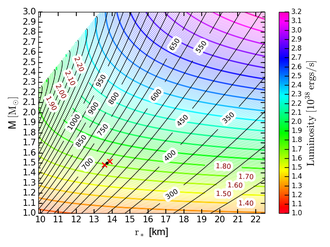
A new method for accurate simultaneous measurement of both the mass and radius of neutron stars has been proposed by a team of scientists from the Copernicus Astronomical Center (CAMK) and Harvard University, led by Deepika Bollimpalli, a PhD student at the Copernicus Astronmical Center and published in the Monthly Notices of the Royal Astronomical Society: MNRAS 487, p.5129 (2019): "Atmospheric oscillations provide simultaneous measurement of neutron star mass and radius".
It is widely accepted that measurements of neutron star mass and radius are the only currently feasible method of constraining the theory of matter at ultra-high densities.
Neutron stars are the most compact celestial objects observed in the Universe with their core densities exceeding the nuclear density. The physics governing the matter at such high densities is uncertain, with a wide range of equations of state of dense matter having been proposed describing the properties of ultra-dense matter. Each equation of state corresponds to a unique mass - radius relation for a neutron star at a definite rotation rate. Thus, measuring the mass and radius of the observed neutron stars will constrain the equation of state (EoS). Most methods of determining mass and radius rely on X-ray spectroscopy and to date, sufficiently accurate results have not been obtained to effectively measure the EoS, although constraints have been imposed.
The authors D. Bollimpalli, M. Wielgus, D. Abarca, & W. Kluźniak, propose a new method for accurate simultaneous measurement of both the mass and radius along with the distance to the source. The team has computed the oscillation frequencies of "levitating" atmospheres, supported at a certain height above the stellar surface by the radiation pressure from the luminous neutron star. The key result of this work is that frequency of these oscillations depends only on the stellar parameters and luminosity which allows the direct measurement of the mass and radius given the observations of maximum frequency and the luminosity. In fact, with this method it could be possible also to directly determine the distance to the neutron star allowing the mass and radius to be measured quite precisely, with an accuracy of about 1%.
Picture: The luminosity of the neutron star and the frequency of its atmospheric oscillations as a function of the stellar radius and mass. It is apparent that the mass and radius can be recovered from a measurement of the frequency and the luminosity.






